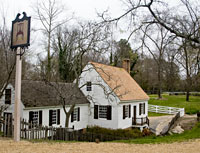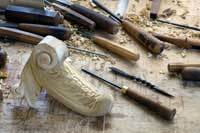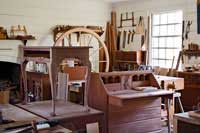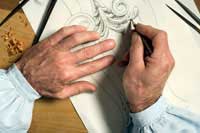Page content
Cabinetmaker
- Fine furniture built by cabinetmakers in colonial cities
- By mid 18th century, only one-third of furniture imported
- Virginians preferred "plain and neat" style of furniture
- Best tidewater construction respected the "nature" of wood
Fine furniture represented trappings of status
Cabinetmakers in colonial Virginia produced fine furniture, but neither England nor the colonies could support full-time furniture producers until the last half of the 17th century. Only then did an adequate number of people have the leisure to enjoy the material trappings that reflected their new status. By the mid-18th century, only one-third of stylish Virginia furniture appears to have come from England. This percentage diminished as patriotic Virginians increasingly honored attempts to boycott English goods as the Revolution neared.
Specialized tools required for furniture making found only in cities
Furniture was produced all over the Virginia colony, but only in the cities could cabinetmaking reach its full potential, as cities served as focal points for the surrounding agricultural inland customers. The most specialized tools and knowledge could only be sustained in the cities. In the tidewater area of Virginia, the best furniture respected the wood's nature to shrink in width but not in length, to a degree rarely seen in any other colonial furniture. The most sophisticated British technology was used to work with the wood's movement, which helped furniture constructed in tidewater shops adjust to inland environments.
First documented cabinetmaker in Williamsburg appeared in 1722
The earliest documented cabinetmaker in Williamsburg was Peter Scott, who first appears in the records in 1722. Scott was a member of Williamsburg's City Council and operated a shop until 1775. Seven masters operated individual shops in Williamsburg by that time. One of the largest and most progressive of these shops had been established by a Scot, Anthony Hay, by 1751. Among Hay's numerous employees were a Virginia-born apprentice, a London-trained journeyman cabinetmaker, a skilled slave cabinetmaker, and a master carver from London. Their customers included fellow Virginians, master tradesmen, merchants, and planters, the established middle class and above. These customers were interested in the "Modern Taste" of French, Chinese, or Gothic mode, now coined "Chippendale" after one of the leading published proponents of the style.
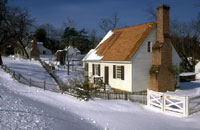
The bright sunshine reflecting off the snow is a welcome sight in Anthony Hay's Cabinetmaking Shop, as the craftsmen work by the natural light coming in through the windows.
Virginians preferred elegant and neatly constructed furniture
Virginians preferred "plain but neat" furniture, modestly elegant and neatly constructed. Ornamentation on furniture was used to emphasize the stature of a person or the importance of the social occasion in which the piece was used. The Hay shop produced a ceremonial chair for Virginia's governor and two more chairs for masters of Masonic lodges in Virginia. The Virginia cabinetmaker's most impressive productions for households were tea and china tables used for entertaining guests. Much of Colonial Williamsburg's antique furniture can be seen at the DeWitt Wallace Decorative Arts Museum.
Art of cabinetmaking takes place today in Hay's Cabinet Shop
Williamsburg's reconstructed cabinet shop, on the site of Hay's business, is open to the public. Today's craftsmen explain the cabinetmaking trade to visitors as they produce furniture with the tools and designs of Hay's era. Today the shop also practices the trade of harpsichord making, documented as part of the shops offerings in 1767. This was a unique service from a colonial Virginia shop; harpsichords were typically English imports in the South.
Learn more:
